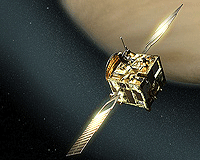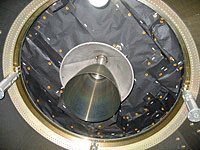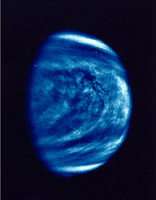Venus or Bust
Air Date: Week of May 5, 2006

Venus Express will study the effects of the solar wind on the Venusian space environment. (ESA - AOES Medialab)
Two NASA satellites and the European Space Agency’s Venus Express have set out to find clues that will aid scientists’ understanding of climate change on Earth. Astrophysicist Neil deGrasse Tyson tells Living on Earth host Steve Curwood about these missions and about why Venus is hot and Earth is not frozen.
Transcript
CURWOOD: From the Jennifer and Ted Stanley Studios in Somerville, Massachusetts, this is Living on Earth. I’m Steve Curwood.
At the end of April NASA launched two satellites into orbit designed to tell us how clouds affect global warming. This is not the only space mission intended to shed light on climate. The Venus Express, a European spacecraft, recently eased into orbit around Venus to study its atmosphere. The craft will circumnavigate the planet nearest to Earth for at least two Venusian days – that’s about 485 Earth days – and gather information to increase understanding about climate change on this planet.
With me now is Neil deGrasse Tyson. He’s an astrophysicist and heads New York’s Hayden Planetarium. Neil, welcome back to Living on Earth.

Venus Express will study the effects of the solar wind on the venusian space environment. (ESA - AOES Medialab)
CURWOOD: I detect that there’s increased interest among the international space agencies in climate change. What are they looking at particularly?
TYSON: The way to think about that is every next mission now knows that climate change is a big issue. And so as you design those spacecraft you’ll design them slightly differently to explore what drivers may be responsible for climate change. In the past, all you really cared about was perhaps tomorrow’s weather, or whether it would rain this afternoon. And so once you understand that there’s something bigger happening you get to change the scope and the vision statement of what it is that drives your satellite design and the questions that you aim to answer with the experiments on board. So, yes, I think we’re all kind of worried. And even people who didn’t used to be worried are worried.
CURWOOD: Now let’s look at NASA’s satellite mission. They’ve got one satellite that is going to be using lidar, which is like radar only it’s laser instead of radio waves, and infrared, to look at clouds. What’s important about clouds in terms of climate change?
TYSON: The atmosphere is one of the most complex systems you could possibly model scientifically. There are all of these drivers – there are heat sources, there are heat sinks, there’s movement of countless numbers of particles, there are aerosols, there’s human intervention with the weather. And when you combine all of this, what you really want is the best possible data you can attain.
And the way to do that is not simply to look up at the bottoms of clouds. You want to look at what they look like from the top, but also you want to probe what’s going on inside of them. So, it’s the three-dimensional structure of clouds that will add to the database of these atmospheric modelers so we can claim to understand what is going on right above our heads.

Close-up view of Venus Express main engine (ESA)
TYSON: Well, first of all, not all of space is NASA. People need to remember that. And there’s not enough attention, I think, given to the rest of the world’s efforts to understand Earth and the solar system. The European Space Agency is one among several. Japan has one. Of course, Russia has one as well. And China has a nascent one.
But these efforts – Europe said they wanted to figure out what’s going on on Venus. Venus is one of the most mysterious places in the solar system. It’s known as our sister planet. It’s about the same size as Earth but it’s completely different climatically. It’s nearly 900 degrees Fahrenheit, and it’s got a thick cloud cover which triggers a runaway greenhouse effect which is responsible for that high temperature.
And so, one of the most mysterious planets – simply because it’s cloaked from our view – needs this kind of attention which we should have given it a long time ago.
CURWOOD: What is in the thick clouds of Venus?

Clouds of Venus, taken from NASA’s Galileo (NASA)
From what we do know about Venus, its surface is interesting because it’s much, much smoother than should be the case given the history of meteor impacts on planet surfaces. And there’s been a long suspicion that the surface got completely repaved by some kind of episodic or catastrophic volcanic activity where lava just sort of spills out into the lowlands, creates these broad, flat smooth surfaces, hiding any cratering record. One of the things people are trying to understand is what’s going on in Venus’ atmosphere, what’s going on Venus’ surface.
CURWOOD: Neil, what are the planets that have greenhouse effects? That is, where the atmosphere lets the sunlight in and blocks radiation from escaping, like Earth and Venus?
TYSON: First, you have to recognize some of the most common greenhouse gases. The one we all know about is carbon dioxide, and that’s most of Venus’ and Mars’ atmosphere. But then there’s also water vapor, makes a good greenhouse gas, as well as methane. And so a look around the solar system for planets that have those in its atmosphere, and there will be energy trapped in that atmosphere, solar energy trapped, and thereby giving those places a slightly or excessively higher temperature than it otherwise would.
For Mars, that increment is about five degrees above what it would otherwise be. Earth, it’s about 35 degrees. In fact, without our greenhouse effect we’d be in a perpetual ice age. Venus is the runaway greenhouse effect where it’s 500 degrees excess temperature brought about from these gases.
CURWOOD: Neil, what decides a planet’s climate?
TYSON: That’s an excellent question because it’s completely different if a planet doesn’t have water when compared with if it does. So on Mars and Venus it’s the sun heating the surface creating the sort of vertical connective currents where basically the atmosphere boils. The lower part heats and hot air rises, as we all know, and goes up to the top and then cycles back down again. So this can create currents not only top-to-bottom but side-to-side, as you have a rotating planet.
On Earth we have not only land but ocean. And so that complicates things because the sun heats the ocean, the ocean puts water vapor into the atmosphere, and sideways air currents carry that water vapor over the land. You get too much of that, you get rainstorms. But, in the end, the sun is completely responsible for what’s going on with our climate. Without the sun we would just have this stagnant atmosphere and we would be frozen. So the sun does a lot of things for Earth, including accounting for our climate.
CURWOOD: Neil deGrasse Tyson heads the Hayden Planetarium in New York. He’s also the new host of PBS’s Nova ScienceNow that begins with this fall season. Neil, thanks for taking this time.
TYSON: It’s a pleasure to be back with you.
Links
Living on Earth wants to hear from you!
Living on Earth
62 Calef Highway, Suite 212
Lee, NH 03861
Telephone: 617-287-4121
E-mail: comments@loe.org
Newsletter [Click here]
Donate to Living on Earth!
Living on Earth is an independent media program and relies entirely on contributions from listeners and institutions supporting public service. Please donate now to preserve an independent environmental voice.
NewsletterLiving on Earth offers a weekly delivery of the show's rundown to your mailbox. Sign up for our newsletter today!
 Sailors For The Sea: Be the change you want to sea.
Sailors For The Sea: Be the change you want to sea.
 The Grantham Foundation for the Protection of the Environment: Committed to protecting and improving the health of the global environment.
The Grantham Foundation for the Protection of the Environment: Committed to protecting and improving the health of the global environment.
 Contribute to Living on Earth and receive, as our gift to you, an archival print of one of Mark Seth Lender's extraordinary wildlife photographs. Follow the link to see Mark's current collection of photographs.
Contribute to Living on Earth and receive, as our gift to you, an archival print of one of Mark Seth Lender's extraordinary wildlife photographs. Follow the link to see Mark's current collection of photographs.
 Buy a signed copy of Mark Seth Lender's book Smeagull the Seagull & support Living on Earth
Buy a signed copy of Mark Seth Lender's book Smeagull the Seagull & support Living on Earth

